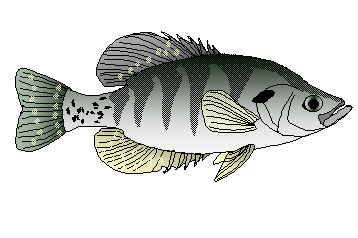Name/Relations || Range/Sizes || Habitat & Habits || Notes
 |
Note: Bar-like coloration on sides, mouth short of mid-eye |
Common Name:
White Crappie
Other Common Names:
sac-a-lait, papermouth, goggleeye, white perch
Scientific name: Pomoxis
annularis
Family: Centrarchidae
(Sunfishes)
Related Species:
Black Crappie, Northern Rock Bass, Green Sunfish
| Range: North America from coast to coast (but patchy) including all of the lower 48 US and southern Canada (Great Lakes Basin). Especially in the Mississippi River System. Stocked widely. |
Sizes:
Max at less than 7 lbs, more common 1lb-2lb
Habitat: Freshwater. Areas with clear to turbid water and heavy structure. In river areas with slow or no current such as sloughs, backwaters, and oxbows. Prefers 65-75 degrees F, but very tolerant of extremes. Schools will often seek deep water structure (up to 60 feet) during the day.
Spawning Habits: Spring spawner, beginning when the water hits 62-68 degrees F . Male digs a nest in coarse sand to marble sized gravel in 3-10 feet of water, then entices females in to mate with him. Females leave only a small quantity of their eggs in each male's nest (spreading their genes as far as possible).
Feeding Habits:
Likes to eat where it lives, usually associated with rocks, fallen trees,
and overhung banks in deeper water, or with nearby deep water, but is highly
attracted to lights at night. Small crappie feed largely on rotifers,
insects, freshwater shrimp, and nymphs, while larger crappie concentrate
on small minnows and larger insects. Due to mouth shape
they concentrate on items above or even with them in depth and will ofen
follow behind a food item and slurp it into their mouths. Feeds mostly
at sunrise, sunset, and in the summer at night.
Notes:
Very popular fish, often confused with its close relative the Black Crappie,
with which it can hybridize. It is also the subject of numerous clubs
and a tournement circuit, along with specialized tackle and lures.
Due to its insect and small minnow habit, it can be a fly rod target at
night or at sunset with #8 wooly worms, small poppers, and streamers, especially
if there is a nearby overhanging bush. More likely these crappie
will be schooled on fallen trees (especially old Chirstmas Trees) near
rocks in deeper water. In the big rivers, this fish will plentiful
in the deeper, snag infested, sloughs, and behind wing dams. It is
far more tolerant of muddy water and current than the black crappie, and
does grow slightly bigger.